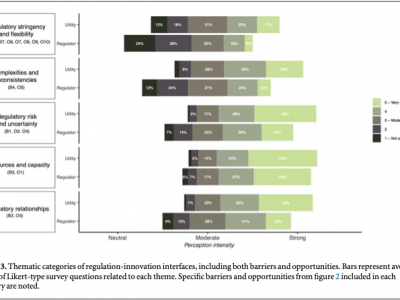Do regulators and utility managers have irreconcilable differences or mutual goals?
By Alida Cantor, Luke Sherman, Anita Milman, and Mike Kiparsky
Do regulators and utility managers have irreconcilable differences or mutual goals?
By Alida Cantor, Luke Sherman, Anita Milman, and Mike Kiparsky.
What do climate change, aging infrastructure, and urban population growth have in common? They all pose major challenges – especially for water infrastructure in the United States. And many utilities are having a hard time keeping up.
Part of the problem is that the industry has relied on the same handful of technologies for decades. The wastewater sector sorely needs to adopt new strategies and technologies. Innovation could serve to improve the ability of utilities to respond to stressors, increasing resilience and providing co-benefits.
 Fortunately, many new technologies for wastewater treatment already exist. For example, membrane filtration technologies, resource recovery processes, nature-based treatment solutions, and advanced monitoring and information technologies present promising opportunities to improve wastewater treatment. Yet, implementation of such innovative technologies has been slow, and wastewater utilities—often described as risk-averse— tend to stick to the tried-and-true.
Fortunately, many new technologies for wastewater treatment already exist. For example, membrane filtration technologies, resource recovery processes, nature-based treatment solutions, and advanced monitoring and information technologies present promising opportunities to improve wastewater treatment. Yet, implementation of such innovative technologies has been slow, and wastewater utilities—often described as risk-averse— tend to stick to the tried-and-true.
At its core, well-tailored environmental regulation can act as a driver of innovation. Through water quality mandates and generous funding for municipal treatment facilities, the Clean Water Act itself has directly resulted in dramatic water quality improvement over the past half century.
At the same time, regulation can be seen as a barrier to innovation. Utilities may understandably shy away from investing in expensive new technologies that are not guaranteed to receive a green light from regulators. In addition, durable infrastructure planning can seem inconsistent with a typical five-year permit cycle: if permit terms tighten before an installation reaches the end of its design life, replacing it could result in higher bills for ratepayers.
Meanwhile regulators can be reluctant to permit unproven, emerging technologies, and might feel more comfortable taking a precautionary approach – and in an important sense they are right to do so given their responsibility to guard against water quality violations.
Given the many risks and the different incentives and roles of utilities and regulators in the regulation process, a common assumption is that the two groups are generally at odds with one another when it comes to their views on regulation and innovation.
New research from our team shows this assumption of oppositionality is far from the truth. In fact, utilities and regulators generally agree about the ways in which regulation acts as a barrier to innovation in the wastewater sector, and how innovation could be encouraged.
For example, utility managers and regulators both see significant potential to encourage innovation in the wastewater sector by improving communication and relationships. They also both agree that limitations in funding and resources serve as a considerable barrier to innovation, and support solutions such as research, pilot project funding, and capacity-building. Crucially, and notably, regulators and utility managers agree that reducing stringency of regulations is not a productive way to encourage innovation.
Why does it matter that utilities and regulators agree on regulation-related barriers and opportunities to encourage innovation? The successful adoption of new technologies requires buy-in from both regulators and utilities. The assumption of conflict, and the attendant expectation of differences and resistance to change, can itself hinder collaboration and creativity, particularly given the high-stakes nature of large capital investment.
So, do utility managers regulators have irreconcilable differences? Our results suggest they do not: contrary to common assumptions about inherent division in motivation and expectations, there is much greater commonality in outlook and purpose between the two communities than might be expected. This new research emphasizes the potential for regulators and utilities to work together to identify and implement innovative solutions to wastewater treatment. The path toward more cost-effective and impactful management of wastewater lies through collaboration, engagement, and support of the regulatory process – a path upon which both regulators and utility manager can agree.
For more details, see our new article, available open access:
Alida Cantor, Luke Sherman, Anita Milman, and Michael Kiparsky. 2021. Regulators and utility managers agree about barriers and opportunities for innovation in the municipal wastewater sector. Environmental Research Communications. 3 031001. https://doi.org/10.1088/2515-7620/abef5d
See also our other recent open access work on this topic:
Luke Sherman, Alida Cantor, Anita Milman, and Michael Kiparsky. 2020. Examining the complex relationship between innovation and regulation through a survey of wastewater utility managers. Journal of Environmental Management. 260, 110025. https://doi.org/10.1016/j.jenvman.2019.110025
These articles are part of a set of publications that examine regulation and innovation in the municipal wastewater sector, funded by US EPA and the NSF ReNUWIt Engineering Research Center.





Reader Comments